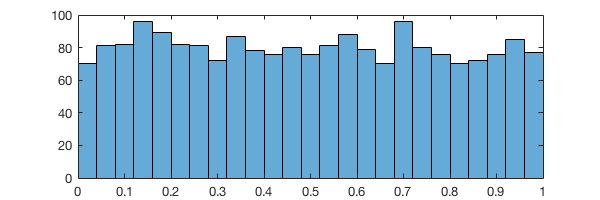Lecture 4: Floats & Random Numbers¶
Date: 09/12/2017, Tuesday
In [1]:
format compact
format long % print more digits
Floating point number system¶
Double precision:
(See lecture slides or textbook for more explantion. This website focuses on codes.)
Maximum value¶
Calculate the maximum value of \(x\) from the formula.
In [3]:
t=52;
f=(2^t-1)/2^t;
(1+f)*2^1023
ans =
1.797693134862316e+308
Compare with the built-in function
In [4]:
realmax
ans =
1.797693134862316e+308
What happens if the value exceeds realmax?
In [5]:
2e308
ans =
Inf
Minimum (absolute) value¶
From the formula
In [6]:
2^-1022
ans =
2.225073858507201e-308
Compare with the built-in function
In [7]:
realmin
ans =
2.225073858507201e-308
MATLAB allows you to go lower than realmin, but no too much.
In [8]:
for k=-321:-1:-325
fprintf('k = %d, 10^k = %e \n',k,10^k)
end
k = -321, 10^k = 9.980126e-322
k = -322, 10^k = 9.881313e-323
k = -323, 10^k = 9.881313e-324
k = -324, 10^k = 0.000000e+00
k = -325, 10^k = 0.000000e+00
\(10^{-323}\) can be scaled up:
In [9]:
1e-323 * 1e300
ans =
9.881312916824931e-24
But \(10^{-324}\) can’t, as it becomes exactly 0.
In [10]:
1e-324 * 1e300
ans =
0
Machine precision¶
Compute machine precision¶
From the formula \(0 \le 2^{t}f<2^{t}, t=52\)
In [11]:
2^(-52)
ans =
2.220446049250313e-16
Built-in function:
In [12]:
eps
ans =
2.220446049250313e-16
Another ways to get eps
In [13]:
1.0-(0.1+0.1+0.1+0.1+0.1+0.1+0.1+0.1+0.1+0.1) % equals to eps/2
ans =
1.110223024625157e-16
In [14]:
7/3-4/3-1 % equals to eps
ans =
2.220446049250313e-16
Difference between eps and realmin¶
realmin is about abosolute magnitude, while eps is about
relative accuracy. Although a double-precision number can represent
a value as small as \(10^{-323}\) (i.e. realmin), the relative
error of arithmetic operations can be as large as \(10^{-16}\) (i.e.
eps).
Adding \(10^{-16}\) to 1.0 has no effect at all.
In [15]:
1.0+1e-16-1.0
ans =
0
Adding \(10^{-15}\) to 1.0 has some effect, although the result is quite inaccurate.
In [16]:
1.0+1e-15-1.0
ans =
1.110223024625157e-15
Not a number¶
In [17]:
0/0
ans =
NaN
In [18]:
Inf - Inf
ans =
NaN
However, Inf can sometimes be meaningful: (MATLAB-only. Not true in
low-level languages.)
In [19]:
5/Inf
ans =
0
In [20]:
5/0
ans =
Inf
Random numbers¶
In [21]:
a = 22695477;
c = 1;
m = 2^32;
N = 2000;
X = zeros(N,1);
X(1) = 1000;
for j=2:N
X(j)=mod(a*X(j-1)+c,m);
end
R = X/m;
Hmm… looks pretty random🤔
In [22]:
%plot --size 600,200
plot(R);

The data also looks like evenly-distributed.
In [23]:
nbins = 25;
histogram(R, nbins);
